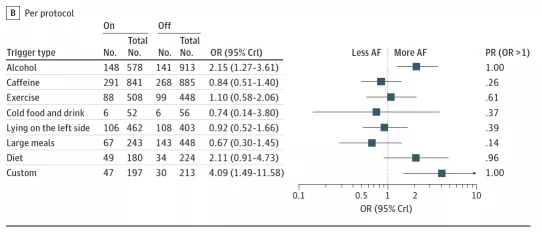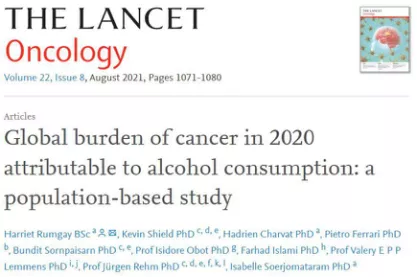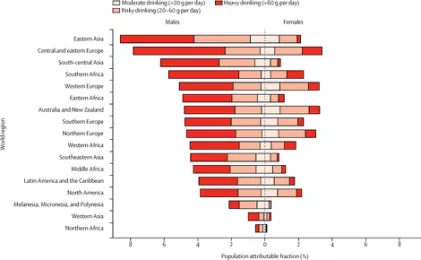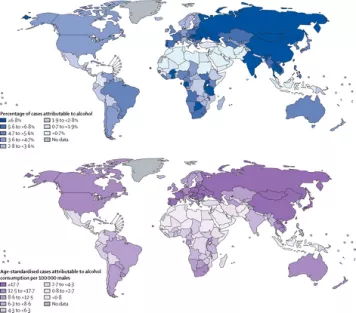The Lancet: A drop of alcohol can also cause cancer!
- A Single US$2.15-Million Injection to Block 90% of Cancer Cell Formation
- WIV: Prevention of New Disease X and Investigation of the Origin of COVID-19
- Why Botulinum Toxin Reigns as One of the Deadliest Poisons?
- FDA Approves Pfizer’s One-Time Gene Therapy for Hemophilia B: $3.5 Million per Dose
- Aspirin: Study Finds Greater Benefits for These Colorectal Cancer Patients
- Cancer Can Occur Without Genetic Mutations?
The Lancet: A drop of alcohol can also cause cancer!
- Red Yeast Rice Scare Grips Japan: Over 114 Hospitalized and 5 Deaths
- Long COVID Brain Fog: Blood-Brain Barrier Damage and Persistent Inflammation
- FDA has mandated a top-level black box warning for all marketed CAR-T therapies
- Can people with high blood pressure eat peanuts?
- What is the difference between dopamine and dobutamine?
- How long can the patient live after heart stent surgery?
The Lancet: A drop of alcohol can also cause cancer! The safest drinking is 0!
The concepts of “moderate drinking is good for health” and “drinking red wine to soften blood vessels” have been deeply rooted in the hearts of the people.
A glass of red wine every day has become a symbol of health and high quality of life. But is this really the case?
In fact, the academic circles’ views on alcohol have gone through different stages. Initially, research believed that alcohol and the incidence of cardiovascular and cerebrovascular diseases showed a U-shaped association, that is, in a small dose range, drinking alcohol may indeed reduce the risk of cardiovascular and cerebrovascular diseases.
However, with the deepening of research, this view was gradually discarded. “The Lancet” once stated that according to a large sample of data, even small doses of alcohol can increase the risk of cardiovascular and cerebrovascular diseases, especially the East Asian population is more sensitive to it.
This year’s JAMA magazine also published an article saying that alcohol can cause arrhythmia. The researchers observed 466 patients for 10 weeks and determined that alcohol intake would increase the risk of atrial fibrillation.

doi:0.1001/jamacardio.2021.5010
They also studied other lifestyles that may increase the incidence of atrial fibrillation, such as coffee intake and reduced sleep, and found that these factors did not increase the risk of atrial fibrillation, and alcohol was therefore regarded as the most important cause of atrial fibrillation.
At the same time, it has been confirmed that even a small amount of alcohol will increase the occurrence of cardiovascular and cerebrovascular events.
As another major killer of health, the relationship between cancer and alcohol has also attracted academic attention.
So far, alcohol has been proven to be causally related to cancers of the upper respiratory, digestive tract (mouth, pharynx, larynx, esophagus), colon cancer, rectal cancer, liver cancer, and breast cancer.
In order to further clarify the association between alcohol intake and cancer, the international team recently published the latest research results in the sub-Journal of The Lancet, especially emphasizing that drinking alcohol will increase the burden of cancer globally, and there are huge differences between ethnic groups. East Asian races are the first to bear the brunt.

doi: 10.1016 / S1470-2045 (21) 00279-5.
This study uses the International Agency for Research on Cancer GLOBOCAN 2020 database to conduct statistical analysis based on estimates of cancer incidence and data on alcohol consumption patterns around the world, and categorize and evaluate different types of alcohol by gender, cancer type, and country. The impact of the amount on the incidence of cancer.
In this large-scale population study, intake was divided into three types: light drinking (less than 20 grams per day on average), moderate drinking (20-60 grams per day on average) and heavy drinking (over 60 grams per day on average). This classification is helpful for studying whether small amounts of alcohol are really as advertised as harmless to health.
The research team believes that globally , an estimated 740,000 of all new cancer cases in 2020 can be attributed to drinking .
Among men, there are nearly 570,000 cases of cancer caused by alcohol, and among women, this number is about 170,000.
Among them, liver cancer, esophageal cancer and breast cancer are most affected by alcohol.
After age standardization, the research team found that the global incidence of cancer caused by alcohol was 8.4 per 100,000 people.
Men are more susceptible to the effects of alcohol than women, and the incidence of cancer caused by alcohol is 13.4 per 100,000 people, which is significantly higher than the 3.7 per 100,000 women.
Through the calculation of the population attribution score, they found that if the alcohol consumption is reduced to 0, the incidence of esophageal cancer, pharyngeal cancer, and lip cancer will show the greatest improvement, about 31.6%, 22.0%, and 20.2%, respectively .
This improvement is more pronounced in men. For example, 39.2% of esophageal cancer in men can be attributed to alcohol, while 14.3% in women.

doi: 10.1016 / S1470-2045 (21) 00279-5.
Then, the researchers found that East Asia was most affected by alcohol . For example, China and Mongolia have the largest proportion of new cancers due to cancers caused by drinking.
In terms of gender, East Asian men seem to be more likely to be affected by alcohol and develop tumors, while East Asian women are less affected than men, but they still rank high in the world.
Further statistics on incidence rates in different regions show that East Asian men are susceptible to cancer after drinking. The incidence of alcoholic cancer is 21.5 per 100,000 people, second only to 23.1 per 100,000 people in Central and Eastern Europe.

doi: 10.1016 / S1470-2045 (21) 00279-5.
The top three regions with the incidence of female alcoholic cancer are Australia, Western Europe and Northern Europe, with incidence rates of 10.2 per 100,000, 9.4 per 100,000, and 9.1 per 100,000 respectively.
Another interesting finding is that the incidence of alcoholic cancer in men and women in Australia, Western Europe and Northern Europe is roughly similar, but in Asia, especially in East Asia and Southeast Asia, the incidence in men is nearly 7 times that of women . This indicates that the dangers of drinking in East Asian men require extra pay attention to.
The research team also confirmed that small amounts of alcohol can also induce tumors . In all cancer cases caused by drinking, about 14% of patients have an average daily alcohol intake of less than 20 grams, which is a small amount of alcohol. The proportion of tumors caused by moderate and heavy drinking was even higher, accounting for 39.4% and 46.7%, respectively.

doi: 10.1016 / S1470-2045 (21) 00279-5.
In view of this, the author stated that a cancer warning can be added to alcohol labels, similar to the warnings used on tobacco products, which can increase public awareness of the causal relationship between alcohol and cancer, thereby reducing the consumption of alcoholic beverages.
At this stage, a total prohibition of alcohol is not in line with China’s national conditions and runs counter to our cultural traditions. But as advocated by the World Health Organization, we can gradually reduce the supply of alcohol and raise prices through taxes, so as to achieve reasonable control of alcohol. Have a drink, but don’t be greedy.
references:
1.Harriet Rumgay, et al. Global burden of cancer in 2020 attributable to alcohol consumption: a population-based study. Lancet Oncol, 2021, 22(8): 1071-1080. doi: 10.1016/S1470-2045(21)00279-5.
2.Gregory M Marcus, et al. Individualized Studies of Triggers of Paroxysmal Atrial Fibrillation: The I-STOP-AFib Randomized Clinical Trial. JAMA Cardiol, 2021, e215010. doi: 10.1001/jamacardio.2021.5010.
The Lancet: A drop of alcohol can also cause cancer!
(source:internet, reference only)
Disclaimer of medicaltrend.org
Important Note: The information provided is for informational purposes only and should not be considered as medical advice.



